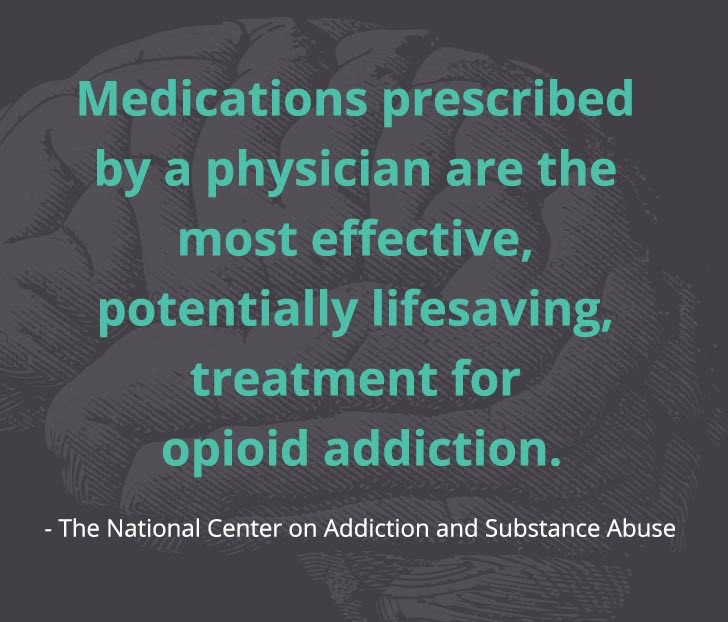Recovery from opioid addiction is a process. Detox and medication-assisted treatment help your brain recover from changes caused by opiates and opioids. Counseling and therapy teach recovery skills and coping techniques necessary for avoiding relapse.
- Days 0–10: Detox or initiation of methadone/buprenorphine
- Day 10: Initiation of naltrexone (optional)
- Days 10–28: Residential counseling, therapy and medication-assisted treatment
- Days 28–90: Outpatient counseling, therapy and medication-assisted treatment
- Days 90–365: Support group attendance, therapy as needed and medication-assisted treatment
- Days 365+: Taper off of medication-assisted treatment (optional)
Some people take medications for opioid addiction for months or years after leaving rehab. Many people access aftercare resources, such as support groups or sober living homes, after treatment. People take different paths to recovery, but each path begins with asking for help.

Types of Opioid Addiction Treatment
The goal of rehab is to help you overcome two side effects of regular opioid use: dependency and addiction.
Dependency refers to physical changes in the brain that make a person rely on opioids to function. Without opioids, a dependent person experiences painful withdrawal symptoms. Addiction refers to behavioral problems associated with opioid misuse.
The Substance Abuse and Mental Health Services Administration separates opioid treatment into three categories:
- Detoxification
- Medically supervised withdrawal
- Medical maintenance treatment
These approaches are differentiated by the type and duration of services they provide. Types of services include medication-assisted treatments, individual counseling, group therapy and aftercare support. Your condition determines the appropriate approach for you.
Looking for opioid rehab?
Let us help you find treatment that is specifically catered to you.
Detoxification
The goal of detox is to help you overcome dependency on opioids. At the beginning of detox, patients are dependent on opioids and are not on a medication-assisted treatment plan. Medications may be used to slowly taper you off opioids but aren’t intended for long-term use. Short-term counseling and group therapy may be introduced to increase motivation to complete detox.
Medical Maintenance Treatment
The goal of medical maintenance treatment is to relieve cravings and withdrawal so you can focus on counseling and therapy. Instead of detoxing from opioids, you’ll receive methadone or buprenorphine for at least 21 days. This therapy is sometimes called opioid replacement therapy. While you’re maintained on a medication, you’ll receive varying degrees of counseling, therapy and social support.
Medically Supervised Withdrawal
If you were introduced to methadone or buprenorphine during detox or if you were medically maintained on the medications, you’ll eventually transition to medically supervised withdrawal. The goal is to discontinue these medications. This stage may occur between detox and counseling, or it may occur after years of sustained recovery.

Opioid Detox
Unfortunately, maintenance medications such as buprenorphine and methadone are not available at every rehab facility. For many people, opioid rehab begins with medical detox.
During detox, treatment specialists make you as comfortable as possible while you get through opioid withdrawal. Rehab centers may use non-opioid medications to treat pain, nausea and other symptoms.
Withdrawal from short-acting opioids, such as heroin, can begin within eight hours of last use. It usually lasts between three and five days. However, withdrawal can last up to 10 days, according to the World Health Organization.
If medications are used, opioid detox is followed by medically assisted withdrawal. A doctor can help you determine what type of detox is best for you.
- Duration of opioid use
- Type of opioid(s) used
- Frequency of use
- Tolerance
- Method of administration
- Age
- Medical history
- Support system
- Living environment
Most people do not attend individual counseling or therapy sessions during detox. They may attend group therapy or other services designed to increase motivation to continue treatment, but behavioral therapy is not recommended until the worst withdrawal symptoms dissipate.

Medication-Assisted Treatment During Opioid Rehab
Medication-assisted treatment refers to the use of methadone, buprenorphine or naltrexone in combination with behavioral therapy. Methadone and buprenorphine can be administered temporarily or for multiple years.
The length of methadone or buprenorphine treatment is determined by you and your doctor. Long-term use of methadone or buprenorphine is sometimes called opioid replacement therapy. Both medications are opioids with low potential for abuse.
About a week after all withdrawal symptoms have dissipated, doctors can prescribe naltrexone. Naltrexone blocks the pleasurable effects of opioids and reduces cravings. It doesn’t ease symptoms of withdrawal. Naltrexone reduces relapse by decreasing a person’s incentive to use opioids.
If you take naltrexone before detox, you can experience precipitated withdrawal. Precipitated withdrawal occurs when a medication, such as naltrexone of buprenorphine, makes a person suddenly experience severe withdrawal symptoms.
Medication-assisted treatment is considered a vital component of opioid rehab. Center on Addiction states that “medications prescribed by a physician are the most effective, potentially lifesaving, treatment for opioid addiction.”
Unfortunately, some rehab facilities do not offer MATs for opioid addiction. Individuals with severe opioid use disorders should not attend a facility that doesn’t offer at least one MAT. For people with severe opioid use disorders, multiple months or years of maintenance treatment may be necessary for long-term recovery.

Therapy & Counseling
Counseling and therapy begin once you’ve finished detox or you’ve been stabilized by a maintenance medication such as methadone or buprenorphine.
Therapy treats problematic behaviors associated with addiction. You’ll learn healthy ways to process information and manage emotions. You’ll develop safe coping strategies. You’ll also learn about opioid side effects and how to avoid relapse.
A variety of therapeutic techniques can assist people in recovery from opioid addiction. Common types of therapy include cognitive behavioral therapy, dialectical behavioral therapy, contingency management, community reinforcement approach and family-based therapies.
- One-on-one appointments
- Group sessions
- Educational classes
- Family meetings
- Over the phone
- Online
- Outdoor meeting areas
During inpatient therapy, you will attend at least one individual therapy session each week. You will also attend daily educational classes and multiple group therapy sessions each week. Most insurance plans cover inpatient rehab for between two and four weeks.
You’ll then transition to outpatient therapy, which can continue indefinitely. During outpatient therapy, clients usually attend multiple one-on-one therapy sessions each week. As you maintain longer durations of sobriety, the frequency of therapy decreases.

Self-Help Groups & Aftercare
Peer support is a key component of many treatment plans. During inpatient or outpatient therapy, some rehab centers assign a peer recovery coach or a peer leader to clients. These people can connect with individuals trying to recover from addiction. They share personal stories and recovery tips.
You’ll likely be introduced to peer support groups, such as 12-step programs, during rehab. Or you’ll be referred to self-help groups after discharge. Peer support groups help people in recovery stay accountable, learn from others and develop a sense of purpose.
Other aftercare resources can also help you transition to normal life. Some rehab clinics provide aftercare support after discharge.
- Safe living environments
- Financial coaching
- Life skills training
- Vocational training
- Job placement services
Peer support and aftercare services decrease the chances of relapse by helping you rebuild your life. Without access to a sober home or stable employment, people are more likely to relapse into drug use. With access to people who care and resources to learn new skills, you can pursue your dreams.

Discontinuing Medication for Opioid Addiction
Many people continue to take methadone, buprenorphine or naltrexone after being discharged from rehab. The medications can be essential recovery resources during the first months or years of recovery.
Eventually, you may want to discontinue medication-assisted treatment. The risks of relapse increase when a person stops taking medication for opioid addiction, but you may be a candidate for discontinuation of treatment once you’ve maintained several months or years of sobriety.
- Length of abstinence
- Strength of support system
- Motivation for discontinuation
- Access to recovery resources
Patients who are noncompliant with treatment are also candidates for discontinuation. These clients should be referred to other rehab services that may be more appropriate.
Discontinuing methadone or buprenorphine can take several months because stopping abruptly can cause withdrawal. The dosage of medication is slowly reduced until you no longer experience cravings or symptoms of withdrawal.
Naltrexone does not cause withdrawal. It may be discontinued immediately if you and your doctor agree the risk of relapse is low.
Many people think of opioid rehab as a seven- or 30-day stay at a treatment facility. But recovery takes more than one month. Detox isn’t the only component of rehab. Residential therapy isn’t the final stage of recovery.
The best rehab programs provide structured treatment, including outpatient therapy and aftercare, for multiple months. Many patients maintain their recovery without relapse for more than a year with the help of support groups and medication. By participating in a comprehensive treatment program, you can recover from opioid addiction.
Medical Disclaimer: DrugRehab.com aims to improve the quality of life for people struggling with a substance use or mental health disorder with fact-based content about the nature of behavioral health conditions, treatment options and their related outcomes. We publish material that is researched, cited, edited and reviewed by licensed medical professionals. The information we provide is not intended to be a substitute for professional medical advice, diagnosis or treatment. It should not be used in place of the advice of your physician or other qualified healthcare provider.
Author
Senior Content Writer,
DrugRehab.com
Chris Elkins worked as a journalist for three years and was published by multiple newspapers and online publications. Since 2015, he’s written about health-related topics, interviewed addiction experts and authored stories of recovery. Chris has a master’s degree in strategic communication and a graduate certificate in health communication.
View Sources
 Addiction
Addiction
 Treatment
Treatment
 Faith & Religion
Faith & Religion
 Active Recovery
Active Recovery
 Our Community
Our Community










